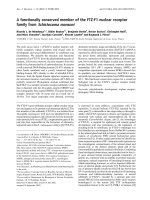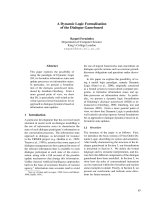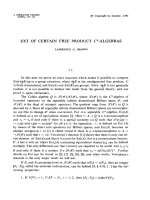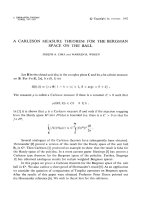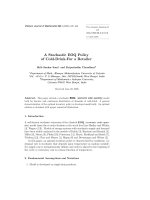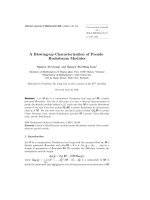Báo cáo toán học: "A duality based proof of the Combinatorial Nullstellensatz Omran Kouba" pps
Bạn đang xem bản rút gọn của tài liệu. Xem và tải ngay bản đầy đủ của tài liệu tại đây (64.93 KB, 3 trang )
A duality based proof of the Combinatorial Nullstellensatz
Omran Kouba
Department of Mathematics
Higher Institute for Applied Sciences and Technology
P.O. Box 31983, Damascus, Sy ria
omran
Submitted: Dec 21, 2008; Accepted: Mar 5, 2009; Published: Mar 13, 2009
Mathematics Subject Classifications: 05A99, 15A03
Abstract
In this note we present a proof of the combinatorial nullstellensatz using simple
arguments from linear algebra.
The combinatorial nullstellensatz [1] is an elegant tool which has many applications
in combinatorial number theory, graph theory and combinatorics (see [1] and [2]). In
this note we present a proof of this result using simple arguments from linear algebra.
In Theorem 1, we recall the statement of the combinatorial nullstellensatz:
Theorem 1. Let P be a polynomial in m variables X
1
, X
2
, . . . , X
m
over an arbitrary
field K. Suppose that the coefficient of the monomial X
n
1
1
X
n
2
2
· · · X
n
m
m
in P i s nonzero,
and that the total degree of P is
m
j=1
n
j
. Then, if S
1
, S
2
, . . . , S
m
are subsets of K such
that card (S
j
) > n
j
(for 1 ≤ j ≤ n,) there is some (t
1
, t
2
, . . . , t
m
) in S
1
× S
2
× · · · × S
m
so that P (t
1
, t
2
, . . . , t
m
) = 0.
Our proof is based upon a simple lemma concerning linear forms on the vector
space K[T ] of polynomials in one variable T over an arbitrary field K. In the dual space
(K[T ])
∗
, we consider the dual basis (ϕ
m
)
m≥0
of the canonical basis (T
m
)
m≥0
of K[T ],
this means that ϕ
m
(P ) is the coefficient of T
m
in P, in other words ϕ
i
(T
j
) = δ
ij
where
δ
ij
is the Kronecker symbol. We also denote by K
n
[T ] the subspace of K[T ] formed of
polynomials of degree at most n.
With the above nota tion we have the following lemma :
Lemma 2. Let S be a subset of K such that card (S) = m + 1. Then there is a family
(λ
S
t
)
t∈S
of elements in K such that
∀ P ∈ K
m
[T ], ϕ
m
(P ) =
t∈S
λ
S
t
P (t).
the electronic journal of combinatorics 16 (2009), #N9 1
Proof. Consider, for t ∈ S, the linear form µ
t
: K
m
[T ] −→ K, µ
t
(P ) = P (t). The
family (µ
t
)
t∈S
constitutes a basis of the dual space (K
m
[T ])
∗
. (To see this, note that if
(ℓ
t
)
t∈S
denotes the basis of K
m
[T ] formed by the Lagrange intepolation polynomials :
ℓ
t
(T ) =
s∈S\{t}
T −s
t−s
, then µ
u
(ℓ
v
) = δ
uv
. This proves that (µ
t
)
t∈S
is the dual basis of
(ℓ
t
)
t∈S
.)
Now, t he linear form P → ϕ
m
(P ) defines an element from (K
m
[T ])
∗
and, con-
sequently, it has a unique expression as a linear combination of the elements of the
basis (µ
t
)
t∈S
. This proves the existence of a familly of scalars (λ
S
t
)
t∈S
, such that
ϕ
m
(P ) =
t∈S
λ
S
t
µ
t
(P ) for any polynomial P in K
m
[T ], and achieves the proof of
Lemma 2.
Before proceeding with the proof of Theorem 1, let us recall that the total degree
of a polynomial P from K[X
1
, . . . , X
m
] is the largest value of d
1
+ d
2
+ · · · + d
m
taken
over all monomials X
d
1
1
X
d
2
2
· · · X
d
m
m
with nonzero coefficients in P .
Proof of Theorem 1. For each j in {1, . . . , m}, we may assume that card (S
j
) = n
j
+ 1
(by discarding the extra elements if necessary,) then, using Lemma 2, we find a familly
of scalars (λ
S
j
t
)
t∈S
j
such that
∀ P ∈ K
n
j
[T ], ϕ
n
j
(P ) =
t∈S
j
λ
S
j
t
P (t). (1)
Then, we consider the linear form Φ on K[X
1
, . . . , X
m
] defined by :
Φ(Q) =
(t
1
, ,t
m
)∈S
1
×···×S
m
λ
S
1
t
1
λ
S
2
t
2
· · · λ
S
m
t
m
Q(t
1
, t
2
, . . . , t
m
).
Clearly, we have
Φ(X
d
1
1
X
d
2
2
· · · X
d
m
m
) =
t
1
∈S
1
t
2
∈S
2
· · ·
t
m
∈S
m
λ
S
1
t
1
λ
S
2
t
2
· · · λ
S
m
t
m
t
d
1
1
t
d
2
2
. . . t
d
m
m
=
m
j=1
t∈S
j
λ
S
j
t
t
d
j
.
So we have the following two properties:
i. If there is some k in {1, . . . , m} such that d
k
< n
k
, then by ( 1) we have
t∈S
k
λ
S
k
t
t
d
k
= ϕ
n
k
(T
d
k
) = 0,
and therefore, Φ(X
d
1
1
X
d
2
2
· · · X
d
m
m
) = 0.
the electronic journal of combinatorics 16 (2009), #N9 2
ii. On the other hand,
Φ(X
n
1
1
X
n
2
2
· · · X
n
m
m
) =
m
j=1
ϕ
n
j
(T
n
j
) = 1.
Let us suppose that
P =
(d
1
,d
2
, ,d
m
)∈D
b
d
1
,d
2
, ,d
m
X
d
1
1
X
d
2
2
· · · X
d
m
m
,
where we collected in D the multi-indexes (d
1
, d
2
, . . . , d
m
) satisfying b
d
1
,d
2
, ,d
m
= 0.
Now, if (d
1
, d
2
, . . . , d
m
) is an element from D which is different from (n
1
, n
2
, . . . , n
m
),
then there is some k in {1, . . . , m} such that d
k
< n
k
because deg(P ) =
m
j=1
n
j
.
Therefore, by (i.), if (d
1
, d
2
, . . . , d
m
) is an element from D which is different from
(n
1
, n
2
, . . . , n
m
), then Φ(X
d
1
1
X
d
2
2
· · · X
d
m
m
) = 0, and if we use (ii.) we conclude that
Φ(P ) =
(d
1
,d
2
, ,d
m
)∈D
b
d
1
,d
2
, ,d
m
Φ(X
d
1
1
X
d
2
2
· · · X
d
m
m
) = b
n
1
,n
2
, ,n
m
= 0.
Finally, the conclusion of the theorem follows since
(t
1
, ,t
m
)∈S
1
×···×S
m
λ
S
1
t
1
λ
S
2
t
2
· · · λ
S
m
t
m
P (t
1
, t
2
, . . . , t
m
) = Φ(P ) = 0.
This ends the proof of Theorem 1.
References
[1] Alon, N., Combinatorial Nullstellensatz. Recent trends in combinatorics. (M´atra-
h´aza, 1995). Combin. Pro bab. Comput. 8 (1999), 7–29.
[2] Shirazi, H. and Verstra
¨
ete, J., A note on polynomials and f-factors of graphs.
Electronic J. of Combinatorics, 15 (2008), #N22.
the electronic journal of combinatorics 16 (2009), #N9 3

